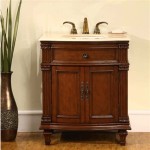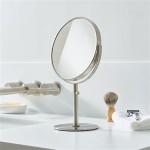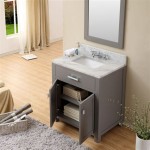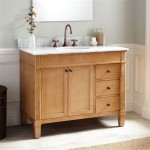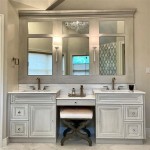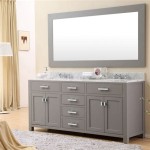```html
Choosing the Right 30 x 18 Vanity Top for Your Bathroom
Selecting the appropriate vanity top is a crucial step in any bathroom renovation or construction project. The vanity top serves as both a functional workspace and a focal point within the bathroom, influencing the overall aesthetic and usability of the space. Among the various available sizes, the 30 x 18 vanity top represents a common and versatile choice, particularly well-suited for smaller bathrooms, powder rooms, or spaces where maximizing floor area is a priority. This article provides comprehensive information on considerations when choosing a 30 x 18 vanity top, covering materials, styles, installation, and maintenance.
Understanding Dimensional Considerations
The dimensions of 30 x 18 inches dictate the physical footprint of the vanity top. The 30-inch width provides adequate surface area for a standard sink basin and a limited amount of countertop space for toiletries and accessories. The 18-inch depth is relatively shallow, making it ideal for bathrooms where space is constrained. It is essential to accurately measure the available space in the bathroom before purchasing a vanity top. Consider the placement of existing plumbing, electrical outlets, and other fixtures that may impact the installation process. A mock-up using cardboard or tape can help visualize the proportions of the 30 x 18 vanity top within the room and ensure it does not obstruct doorways or interfere with movement.
Beyond the overall dimensions, it is also important to consider the thickness of the vanity top. Common thicknesses range from 0.75 inches to 1.5 inches. A thicker vanity top can create a more substantial and luxurious appearance, while a thinner top may be more appropriate for a minimalist or contemporary design. The thickness also influences the weight of the vanity top, which is a factor to consider during installation.
The placement and size of the sink cutout are crucial. 30 x 18 vanity tops typically accommodate a single sink basin. The type of sink – undermount, drop-in, or vessel – will dictate the cutout specifications. Undermount sinks require precise cutouts to ensure a seamless fit. Drop-in sinks, also known as self-rimming sinks, are easier to install as they simply drop into a pre-cut opening. Vessel sinks sit on top of the vanity top and require only a hole for the drain. The location of the faucet holes should also be considered, ensuring they align with the chosen faucet fixture.
Material Selection: Balancing Aesthetics and Functionality
The material of the 30 x 18 vanity top significantly impacts its durability, maintenance requirements, and aesthetic appeal. Common materials include:
- Granite: A natural stone known for its durability, heat resistance, and unique variations in color and veining. Granite vanity tops are resistant to scratches and stains when properly sealed. However, granite is a porous material and requires regular sealing to prevent water absorption and staining. Granite is also a relatively heavy material, requiring a sturdy vanity base for support.
- Quartz: An engineered stone composed of crushed quartz and resin. Quartz vanity tops offer consistent color and pattern options, as well as excellent durability and resistance to scratches, stains, and heat. Quartz is non-porous and does not require sealing, making it a low-maintenance option.
- Marble: A luxurious natural stone with distinctive veining and a smooth, cool surface. Marble vanity tops are prized for their beauty but are more porous and susceptible to staining and etching than granite or quartz. Marble requires careful maintenance and the use of pH-neutral cleaning products.
- Solid Surface: An acrylic-based material that is non-porous, stain-resistant, and repairable. Solid surface vanity tops are available in a wide range of colors and patterns and can be seamlessly integrated with sinks and backsplashes. They are relatively lightweight and easy to install.
- Laminate: A cost-effective option consisting of a plastic laminate surface bonded to a particleboard or MDF core. Laminate vanity tops are available in a variety of colors and patterns and are relatively easy to clean. However, laminate is less durable than natural stone or quartz and is susceptible to scratches, chipping, and water damage.
- Wood: Solid wood vanity tops offer a warm and natural aesthetic. Wood requires a protective sealant to prevent water damage and warping. Different types of wood, such as maple, oak, and walnut, offer varying degrees of hardness and grain patterns.
The choice of material should be based on budget, desired aesthetic, and tolerance for maintenance. For high-traffic bathrooms or those prone to spills, quartz or solid surface may be the most practical choices. For a more luxurious look, granite or marble can be considered, provided that proper maintenance is performed.
Style and Design Considerations
The style of the 30 x 18 vanity top should complement the overall design of the bathroom. Consider the existing color scheme, architectural style, and other fixtures in the room. Common styles include:
- Traditional: Characterized by ornate details, raised panel doors, and classic hardware. Traditional vanity tops often feature curved edges and intricate moldings.
- Modern: Emphasizes clean lines, minimalist designs, and a focus on functionality. Modern vanity tops typically have a sleek, streamlined appearance.
- Contemporary: A blend of modern and traditional elements, often incorporating natural materials and neutral colors.
- Farmhouse: Features rustic details, distressed finishes, and a focus on natural materials like wood and stone.
The color of the vanity top should also be carefully considered. Neutral colors like white, gray, and beige are versatile and can complement a variety of design styles. Darker colors, such as black or navy, can create a more dramatic and sophisticated look. Consider the lighting in the bathroom when selecting a color, as different lighting conditions can affect the way colors appear.
The edge profile of the vanity top is another important design element. Common edge profiles include:
- Eased Edge: A simple, slightly rounded edge.
- Bullnose Edge: A fully rounded edge.
- Bevel Edge: An angled edge.
- Ogee Edge: A decorative edge with a complex curve.
The edge profile should complement the overall style of the bathroom and provide a comfortable and safe surface. Sharp edges should be avoided, especially in bathrooms used by children or the elderly.
Finally, consider the backsplash. A backsplash protects the wall from water damage and can also serve as a decorative element. Common backsplash materials include tile, stone, and solid surface. The height of the backsplash can vary depending on the desired level of protection and aesthetic appeal. A 4-inch backsplash is a common choice, but taller backsplashes can provide more protection and create a more dramatic look.
Installation and Maintenance
Proper installation is crucial for the longevity and performance of a 30 x 18 vanity top. It is recommended to hire a professional installer to ensure that the vanity top is properly secured and that all plumbing connections are watertight. Before installation, ensure that the vanity base is level and structurally sound. Shim the vanity base if necessary to ensure a level surface. Apply a bead of silicone caulk along the top edge of the vanity base before placing the vanity top to create a waterproof seal.
Maintenance requirements vary depending on the material of the vanity top. Granite and marble require regular sealing to prevent staining. Quartz and solid surface are non-porous and do not require sealing. Laminate vanity tops should be cleaned with a mild soap and water. Avoid using abrasive cleaners or scouring pads, as these can scratch the surface. Wood vanity tops should be cleaned with a damp cloth and dried immediately to prevent water damage. Use a wood cleaner specifically designed for finished wood surfaces.
Regular cleaning is essential to maintain the appearance of the vanity top. Wipe up spills immediately to prevent staining. Avoid placing hot items directly on the vanity top, as this can cause discoloration or damage. Use coasters or placemats to protect the surface from scratches and stains. Inspect the vanity top regularly for any signs of damage, such as cracks or chips. Repair any damage promptly to prevent further deterioration.
By carefully considering the factors outlined above, homeowners can select a 30 x 18 vanity top that is both functional and aesthetically pleasing, enhancing the overall value and enjoyment of their bathroom space.
```
Meje 30x18 Inch Drop In Rectanglar 3 Holes Bathroom Sink Vanity Top Only White Glossy Finish

Glacier Bay Sidemere 30 In W X 18 D Vanity Driftwood Gray With Porcelain Top Solid White Basin 30609 The Home

Blossom Hanover Freestanding Bathroom Vanity With Acrylic Sink 30 Classic Oak

Blossom Sydney 30 X 18 White Ceramic Vanity Top Us Bath

Meje 30x18 Inch Drop In Rectanglar 3 Holes Bathroom Sink Vanity Top Only For 4 Centerset Faucet White

Volpa Usa American Crafted Vanities Pacific 30 In X 18 D Bath Vanity Gray With Ceramic Top White Basin Mtd 3130g 14

Meje 30x18 Inch Drop In Rectanglar 3 Holes Bathroom Sink Vanity Top Only For 4 Centerset Faucet White

30 In W X 18 D 32 10 H Freestanding Bathroom Vanity White With Drawers And Elegant Ceramic Sink Top

Blossom 30 X 18 White Rectangular Acrylic Vanity Top With Integrated Single Sink And Overflow

30x18 Modern White Freestanding Vanity With 3 Drawers
